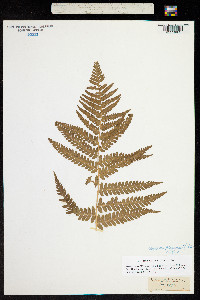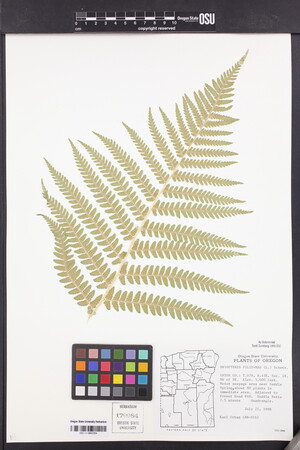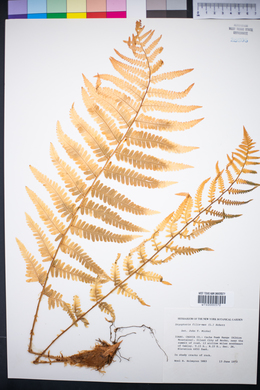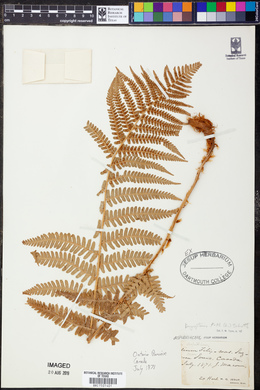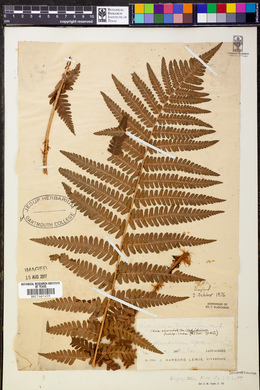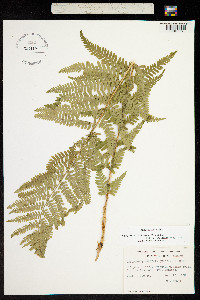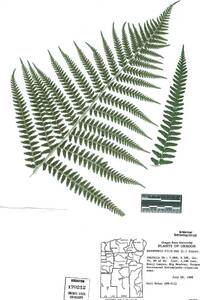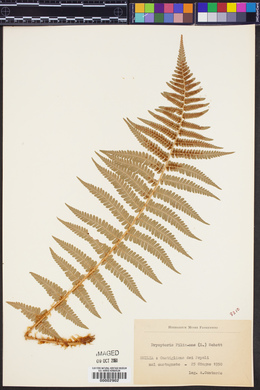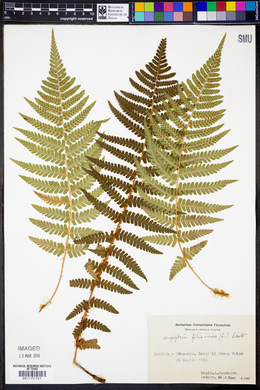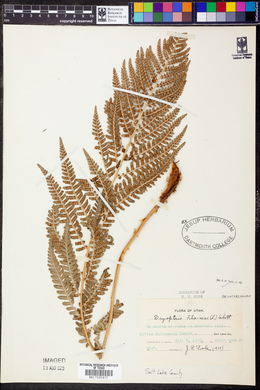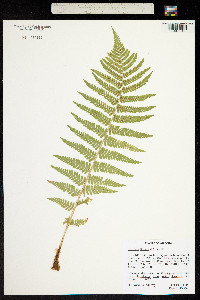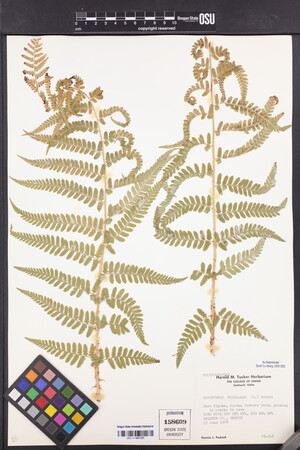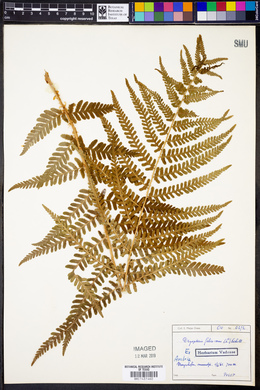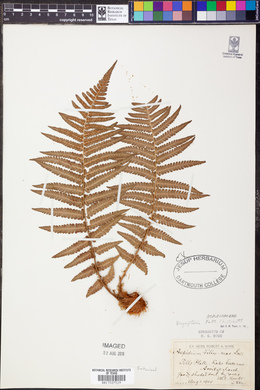Dryopteris filix-mas
|
|
|
|
Family: Dryopteridaceae
Male Fern, more...male woodfern, malefern
[Aspidium filix-mas (L.) Schrad.] |
Leaves monomorphic, dying back in winter, 28--120 × 10--30 cm. Petiole less than 1/4 length of leaf, scaly at least at base; scales scattered, brown, of 2 distinct kinds, 1 broad, 1 hairlike (only this species has 2 distinct forms of scales without intermediates). Blade green, ovate-lanceolate, pinnate-pinnatifid to 2-pinnate at base, firm but not leathery, not glandular. Pinnae ± in plane of blade, lanceolate; basal pinnae ovate-lanceolate, much reduced, basal pinnules or segments ± same length as adjacent pinnules, basal basiscopic pinnule and basal acroscopic pinnule equal; pinnule margins serrate to lobed. Sori midway between midvein and margin of segments. Indusia lacking glands. 2 n = 164. Dense woods and talus slopes on limestone (ne North America); open woods among boulders and talus of granite or igneous rock (Rocky Mountains); 200--2500 m; Greenland; Alta., B.C., Nfld., N.S., Ont., Que., Sask.; Ariz., Calif., Colo., Idaho, Mich., Mont., N.Mex., Nev., Okla., Oreg., Tex., Utah, Wash., Wis., Wyo.; Europe; Asia. The taxonomy of Dryopteris filix-mas is not well understood. In North America, this fern has been considered both an auto- and an allopolyploid and may be composed of at least two closely related taxa. Plants in the northeast and northwest are tetraploid. These differ morphologically and ecologically from a taxon of unknown chromosome number in the southwestern Rocky Mountains. The Rocky Mountain taxon closely resembles the Mexican D . pseudofilix-mas (Fée) Rothmaler. Dryopteris filix-mas also occurs in Europe, and it is known to be an allopolyploid of D . caucasica (A. Braun) Fraser-Jenkins & Corley × oreades Fomin.
General: Fronds 28-120 cm long by 10-30 cm wide, broadly oblong-lanceolate , nearly bipinnate, with blades narrowed at base, often reddish-brown scaly beneath; petiole less than quarter length of leaf, scaly at base. Leaves: Blade green, pinnate to twice pinnate at base, firm but not leathery with segments ovate-oblong, obtuse to acute, ultimate segments toothed or incised, arising obliquely, midribs of pinnae scaly, with midveins of the ultimate segments sparingly so; stipes straw colored, stout, less than half the length of the blade, covered in large brown scales. Sporangia: Sori round, in one row on each side of the midvein near the base of the segment, indusium large, conspicuous, thick and lacking glands. Ecology: Found in dense woods and on limestone talus slopes, often among boulders and talus of granite, and along streams and in rich soil from 6,000-10,000 ft (1829-3048 m). Notes: Only species in the genus that has 2 distinct forms of scales without intermediates, one broad and scalelike and the other hairlike. Ethnobotany: Rhizomes eaten to neutralize some forms of poisoning, infusion of the root is very effective when taken for intestinal worms, taken in order to lose weight, and the rhizomes were simply steamed and eaten. Etymology: Dryopteris is from Greek drys for oak and pteris for fern, while filix-mas is from the Latin filix for fern, and mas, the Latin for male. Sources: FNA 1993, Dittmer et al. 1954, Yarborough and Powell 2002 FNA 1993, Dittmer et al. 1954, Yarborough and Powell 2002 Common Name: male fern Rarity: None General: Fronds 28-120 cm long by 10-30 cm wide, broadly oblong-lanceolate , nearly bipinnate, with blades narrowed at base, often reddish-brown scaly beneath; petiole less than quarter length of leaf, scaly at base. Leaves: Blade green, pinnate to twice pinnate at base, firm but not leathery with segments ovate-oblong, obtuse to acute, ultimate segments toothed or incised, arising obliquely, midribs of pinnae scaly, with midveins of the ultimate segments sparingly so; stipes straw colored, stout, less than half the length of the blade, covered in large brown scales. Sporangia: Sori round, in one row on each side of the midvein near the base of the segment, indusium large, conspicuous, thick and lacking glands. Ecology: Found in dense woods and on limestone talus slopes, often among boulders and talus of granite, and along streams and in rich soil from 6,000-10,000 ft (1829-3048 m). Notes: Only species in the genus that has 2 distinct forms of scales without intermediates, one broad and scalelike and the other hairlike. Ethnobotany: Rhizomes eaten to neutralize some forms of poisoning, infusion of the root is very effective when taken for intestinal worms, taken in order to lose weight, and the rhizomes were simply steamed and eaten. Etymology: Dryopteris is from Greek drys for oak and pteris for fern, while filix-mas is from the Latin filix for fern, and mas, the Latin for male. Synonyms: None Editor: SBuckley, 2010 Rhizome ascending or erect; lvs mostly deciduous, appearing more delicate and finely divided than in spp. 5 and 6; petiole a third as long as the blade, its numerous scales pale, concolored, the broad, toothed ones intermingled with narrow, hair-like ones; blade to 10+ dm, mostly 1.5-3 dm wide; pinnate-pinnatifid with numerous (mostly 20-30 pairs) of pinnae to 15 נ4 cm, the largest pinnae near or a little below the middle and with (15)20+ pairs of segments, many of the segments evidently contracted at the base; larger ultimate segments (0.7-)1-1.5(-2) cm; ramentum ±plentiful on the rachis and costae, sometimes on the lower surface of the blade, chiefly of narrow, elongate, hair-like scales, that of the rachis sometimes partly of more evident (but still narrow) scales; 2n=164. Thickets, moist woods, and streambanks; circumboreal, extending s. to Vt., n. Mich., ne. Ill., S.D., and Mex. Gleason, Henry A. & Cronquist, Arthur J. 1991. Manual of vascular plants of northeastern United States and adjacent Canada. lxxv + 910 pp. ©The New York Botanical Garden. All rights reserved. Used by permission. |
|
|
|

















